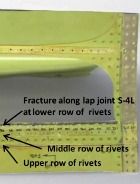
Audio recordings released by the FAA last week of Southwest Airlines Flight 812, a Boeing 737 with 118 passengers aboard that suffered rapid decompression in April, detail pilots and controllers working the problem. The aircraft was at 36,000 feet flying out of Phoenix for Sacramento when a 59-inch-long gash opened nine inches wide in the top of the cabin, with a loud bang. The Southwest pilots immediately declared an emergency and began a descent to 10,000 feet. As the pilots organized, they formulated a plan to return to Phoenix, but as the situation matured they changed plans and sought the nearest available airport. That turned out to be Yuma, Ariz.
Click here for the MP3 file.
The audio has been edited for time. What’s not heard in the edited version is the controllers working together between locations to coordinate their efforts.
The aircraft was a 15-year-old Boeing 737-300. It landed safely at Yuma with a few minor injuries incurred during the rapid descent. NTSB investigators have since determined that misaligned or oblong rivet holes allowed stress points to develop along a bond joint in the 737’s skin. It’s at or near that joint that the skin ultimately failed. The jet had accumulated 48,740 hours through 39,781 cycles (a cycle is one takeoff and one landing). Inspections that were required following the accident turned up four other 737s with crack indications at a single rivet and one with cracking at two rivets. All of those aircraft had flown between 40,000 and 45,000 cycles, according to the NTSB.


































